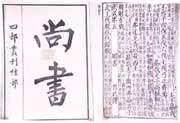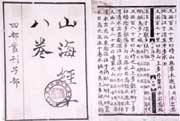|
In the long history of China, many interesting and even legendary records about the Giant Panda can be found. The Giant Panda, because of its much wider range of distribution, had more than a dozen regional names, such as Pixiu, Mo, Zouyu, Whitebear, Flowery-bear, Bamboo-bear and Iron-eating Animal.
The famous Chinese historian Sima Qian of the Han Dynasty notes in Records of the Historian: Records of the Five Emperors, as early as 4000 years ago, a head of a tribe, called Huangdi, used tamed wild animals to defeat another tribe headed by Yandi at Banquan (now Zhulu County of Henan Province). Among these animals, there were tigers, leopards, bears and Pixiu (Giant Pandas). 
Shang Shu (A High Official in Ancient China) and the Book of Poetry compiled in the early years of West Zhou Dynasty also recorded that the skin of the Pixiu (Panda) was a tallage of rarity for the emperor. Giant Pandas were considered an animal that was brave and mighty as tigers and leopards; for that reason, ancient warriors were compared to Giant Pandas, whose anient name Pixiu was used to symbolize victory in all wars.
Book of Mountains and Seas, a classic of the Spring and Autumn and Warring States Period (2700 years ago), the Giant Panda is described as such: with white and black fur, it looks like bear; and found in Yandao County of Qionglai Mountain (the present Rongjing County, Sichuan Province), Giant Pandas were named Iron-eating Animal because it was said that it eats metals.
 Essayist Sima Xiangru of the Han Dynasty (2000 years ago) recorded in On Shanglin Garden, the Emperor Hanwu once had many fowls and animals in Shanglin Garden for the emperor's hunting, and Mo (Giant Panda) was among the most important animals. Essayist Sima Xiangru of the Han Dynasty (2000 years ago) recorded in On Shanglin Garden, the Emperor Hanwu once had many fowls and animals in Shanglin Garden for the emperor's hunting, and Mo (Giant Panda) was among the most important animals.
In the West Jin Dynasty (1700 years ago), Giant Panda was called Zhouyu. For it eats bamboo only, and does not hurt other animals, so it was seen as an "animal of justice', that is, an animal of peace and friendliness.When two forces meet in a fierce battle, if one part shows a flag marked "Zhouyu," the battle will stop: according to ancient principles of war, the flag marked "Zhouyu" means peace and friendship, and the battle should stop.
According to the Imperial Yearbook of Japan, on October 22, 658 A.D., the Emperess Wuzetian sent a couple of Whitebears (Giant Pandas) and 70 pieces of panda fur to Emperor Tianwu of Japan.
When the great poet of Tang Dynasty Bai Juyi was resting in a quiet residence, he felt cold and had a headache because of the chilly wind. Someone then gave him a screen on which a giant panda was painted. The screen brought about a magic effect to drive out his illness. Loving it very much, Bai Juyi wrote a poem, Ode to a Pixiu Screen on the Screen. By saying that giant pandas need a peaceful environment for survival, the poet expresses his concern about the misfortunes and famines brought to the common people by wars.
In Compendium of Materia Medica, the famous pharmacist Li Shizhen of Ming Dynasty recorded: bedding made of panda fur can prevent coldness and wetness, as well as pestilence and vice; oil of panda can penetrate the skin to cure tubers; and its urine, drunk together with water, can dissolve metal things eaten by mistake.
From ancient books and choreographies from the age as early as there were language records we can see that the giant panda has always been a mystical, legendary and rare animal. We can also be sure that giant pandas were once widely distributed in areas like Henan Province in North China, Shanxi Province of Northwest China, Hubei Province and Hunan Province in the middle and lower reaches of Changjiang River, Fujian Provinice in South China, Yunan Province, Guizhou Province, and surrounding mountain areas of the Sichuan Basin.

A study of Giant Panda's name history
|



